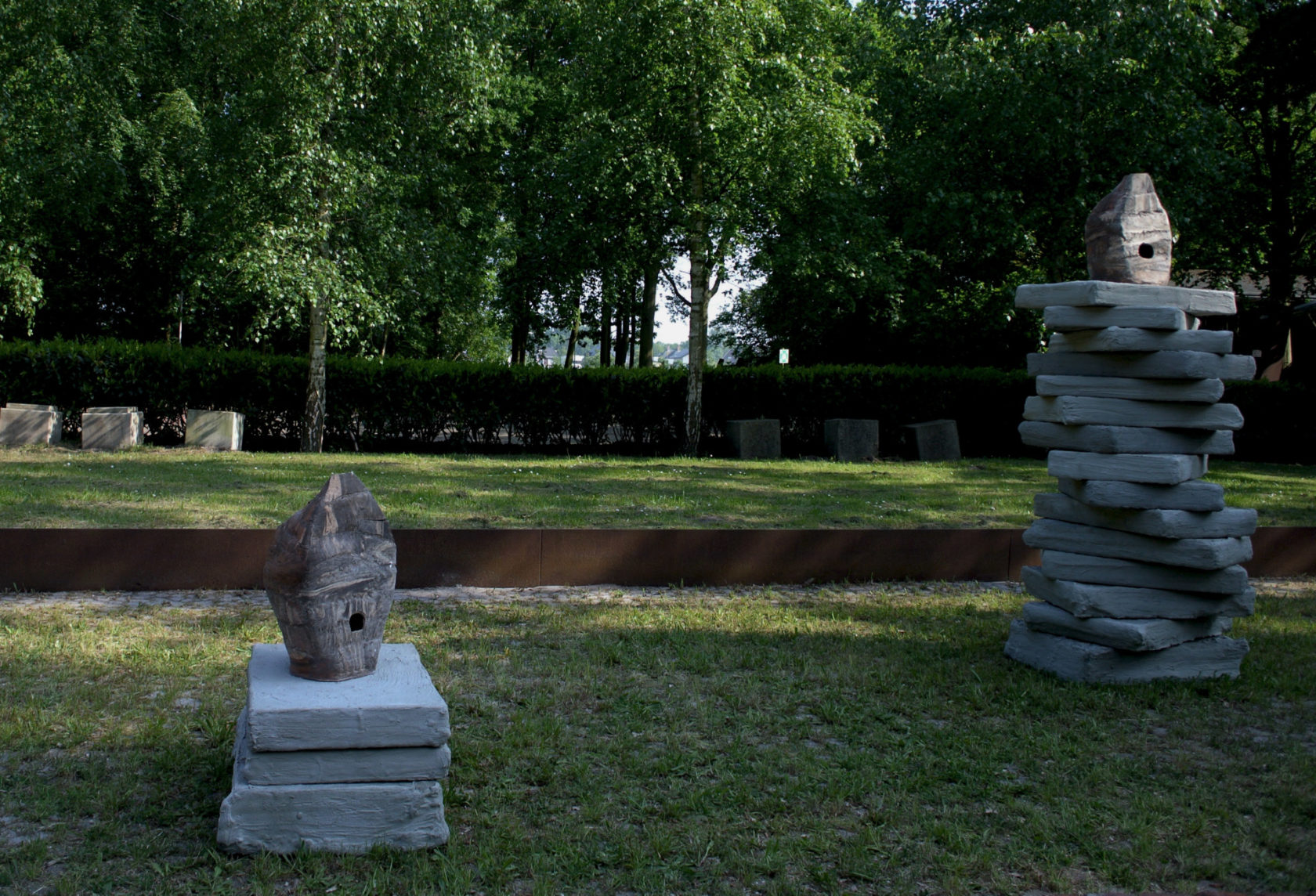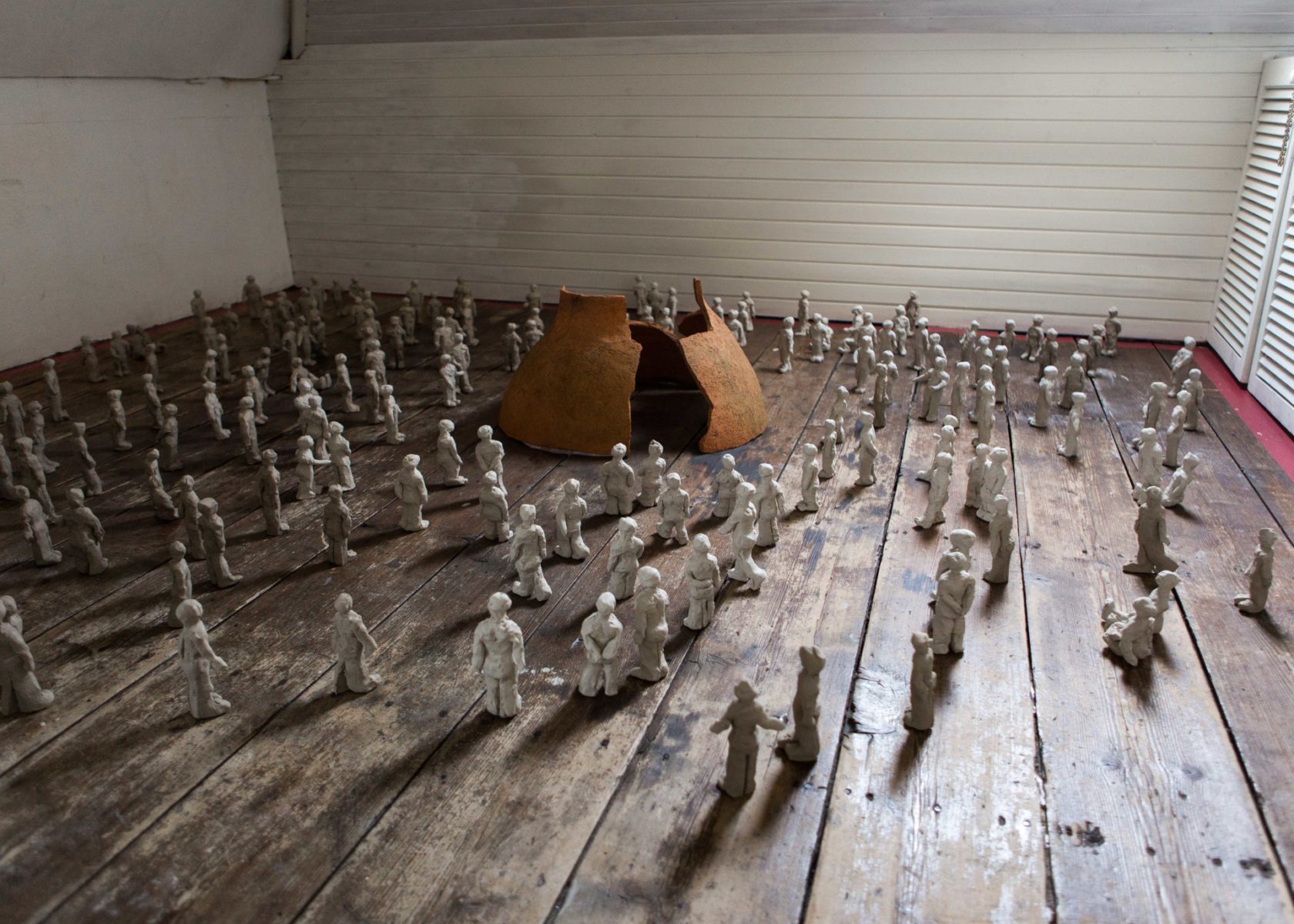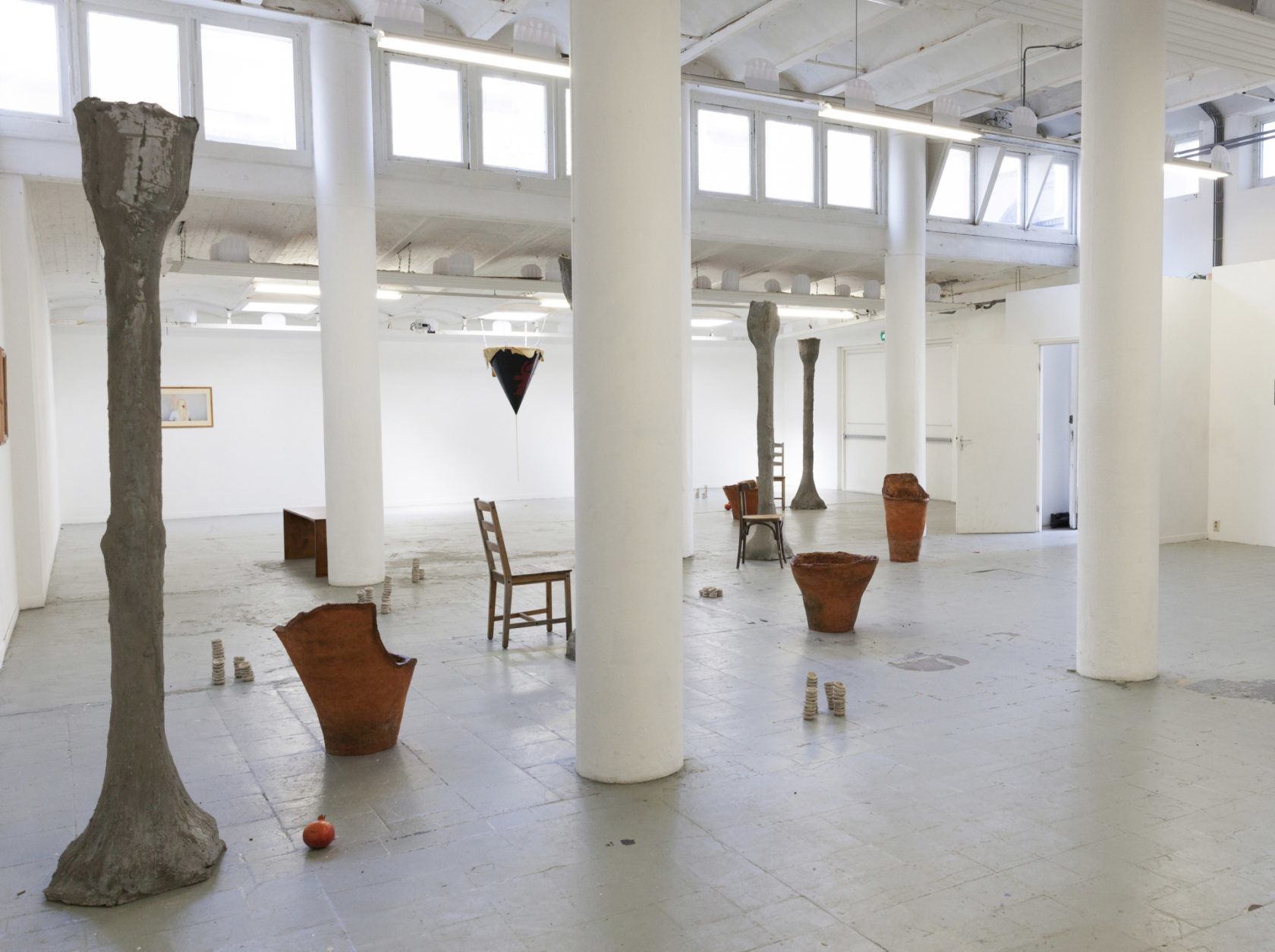Stroom Invest Interviews / artist Iliada Charalambous
The studio of Iliada Charalambous in the Laak neighbourhood in The Hague is a hidden gem. She is preparing for an upcoming show and her space is full of packed and unpacked art works. Iliada studied Fine Arts from 2012 till 2016 in The Hague. Her artistic practise focuses around sculptural installation and site-specific works. She was born and raised in Cyprus and that affects her work.

“My works always seem to start with an idea about politics today. But when I start making the work and it evolves, it becomes more personal and more emotional. So it ends up in something that is more like an emotional response to politics. And this keeps happening for years now. I feel that it is changing a bit.
In the years before, basically since 2015, my work was mainly about the political situation in Cyprus. The economy collapsed in 2012/2013 and the way our government responded, made me think about what the society that we are living in actually is. And about what we can do to make it better and why it is going so wrong. It always made me look back at the cultural symbols of Cyprus and Greece. Because I feel that we have this super heavy history and our pride. Which is not necessarily a bad thing. We are too proud of our past and not think enough about our future. So my work was mainly about that for quite some time. At the moment I feel that I want to open up more. I want to include more global issues, because this kind of issues from my culture and country exist everywhere. It are universal topics and I want to approach them in that way.
My choice of materials is related to my culture and background as well. The materials are formed by their landscape and I really believe that there is a strong connection between landscape and material in the works that I create. I like to work with clay, concrete and wood. And the ruins, the idea of the ruins comes from my culture. That is an image that I keep recreating over the years in different works and different settings.”

Can you tell a bit more about the way you work?
“From the moment I have a concept or idea, I will let it rest in my head for two or three months. And if I still think it is a good idea, I will start to prepare. Within this period, I crystallize the concept I have in my head. That concept is usually more a political statement or a comment. But when I start producing the work, my works are quite labour intensive, they swallow all my current experiences. So if my perspective changes, which happens very often, the work adresses something else. The work includes a political idea, and I can still see that when I explain my works towards an audience, but it is not really what you see by just looking at the work. I am conscious of the fact that my audience sees something else most of the times.”
When is a work finished?
“I often make site specific works. These works are produced in my studio, but I can never see the complete work there. When it is in the exhibition space, set up and ready, it is half finished. Then when the audience comes and starts to interact with the work, it is finished. Of course, the work stays in my head for a long time, even when the physical work does not exist anymore.
Documenting my work is something that I am questioning at the moment now my practise gets a bit more serious. Up until now, it was just photographical documentation. I am considering to have some video documentation as well to get a good feeling what was happening with the audience in the space.”
What made you decide to study art?
“I always wanted to. And that dedication started when I was around 13. I was one of these kids who came home after school and spend six more hours working on art. And I never really wanted to do anything else. In school, I had many options, to study history or English literature for example, but in the end I was more motivated to create. I never wanted another kind of career.
The art culture in Cyprus is really limited. There are only two art centers for example. And in my culture we are not really paying attention to arts. There is no good art education in Cyprus as well. And in general, when you want to have good education you basically have to leave the country. I decided to come to The Hague to study and I was hoping to enter some kind of network as well that would allow me to stay.
I picked the Netherlands, because I wanted to go to a place in Europe with good weather. In my head England has very bad weather. I had never been to the Netherlands before, but I looked amazing on Google. And I really wanted to live in a city that was close to the sea, because I grew up near the sea. So I thought The Hague was perfect in that sense. Of course when I came here I noticed that the weather can be very bad and the sea is grey and cold.”


How does living in the Netherlands influences you?
“To be honest, I have been struggling to find a way to integrate the place where I live into my work. And, even more important, how can I get inspired from the place where I live? The first couple of years were hard. The weather and the cultural differences. It is really different how people approach you and how people talk. In Cyprus for example, it is very temperamental and not so direct. In the Netherlands it is the opposite, very direct and less temperamental. I was homesick when I just arrived. In my second year, the economy collapsed in Cyprus and I was alone here and that happened all there.
I am not sure what Holland brings to my work. Maybe the way my sculptures transformed into free standing sculptures. And being in a more multicultural society contributes to my thinking. As well as the collaborations that are taking place more often.”
Is there somebody or something that influenced you during your studies?
“Definitely, in my third year I decided to go on an exchange to Israel. I found the direction of my work there. Because the political situation in Isreael is extreme, it caused me to start reflecting on politics and identity. That experience was probably the most influential event for my work. The landscape there is exactly like Cyprus, but it is bigger and more bold. I learnt to work with most of the materials there. It was a big step in my work.”
What do you prefer, to work alone or to collaborate?
“When my work involves something I cannot do, I ask for help. In May I have a show in Quartair where I collaborate with a lecturer from Leiden University. That is actually the first time that I am clearly collaborating. And I do enjoy that, I hope that this will happen more often in the future as well. I do like to experiment with more collaborations. On the other hand, I recognise the importance of working alone. My practise is labour intensive and it is kind of meditative as well. That is vital for the way I reflect on the works. It is some sort of process and in that sense it is quite important to keep it as a solo practise.
I do want to interact more with an audience. Some of my works invite the audience to walk through it and in some works the audience is invited to even break the work. For the work where I collaborate with the lecturer from Leiden University, we are trying to see how we can actually start a dialogue with the audience inside the work itself.”

How does an average week look like?
“I have a side job. I spend three days at the job for money, and three days at the studio. And I try to have one day of rest. I am involved with the artist-run space Trixie as well. That involves organizing and meetings. In general, I have a lot of meetings. With young artists for example, with whom I want to organise exhibitions. And I meet people and share my experiences with organising shows.
Since last year I organised two exhibitions myself. Because I don’t want to sit and wait in my studio for invitations. I make work and want that to be displayed outside the studio. So I started taking small steps to organize shows with other young artists. It gives me so much energy. I want to encourage young artists and want to say to them: Just do it!.”
Who do you admire?
“André Kruysen, he was my teacher at the KABK. After my graduation, I got hired as an assistant in the Sculpture and Ceramics Workshop of KABK. I helped André with the sculpture classes for the first year students. He is such an inspirational teacher, especially when it comes to sculpture. Because he is so excited about making and the materials. And because he creates beautiful works. He is such a good and supportive energy.
Last year, I co-organised InYourLivingRoom in the Stenen Kamer. André was also part of the exhibition. It was so great that such an artist wanted to be part of this. For me, it was a long shot to ask him, I was so embarrassed, but he said yes and he was so supportive. That was inspirational and really nice. I admire him, both as a person and as an artist.”
What are the challenges of being an artist?
“Survival is a big challenge. You have to sustain your practise and live as well. I have a side job for three days a week. That is not so much, but I cannot afford to work more, because else I cannot run my practise. On the other hand, the works that I produce are also cost-full, and if I don’t have a grant, I have to invest. That is not cheap. I can manage, but I don’t live a luxurious life. Time is a challenge as well, because, again three days of work and three days at the studio and one day of rest. One day of rest sometimes means work as well, like working on applications or attending a meeting. These are a few challenges, and I hope this will get better in the future.”
How do you see that future?
“That is a hard question, I don’t know. Well, I would like to be able to be an established artist and I would like to have the qualifications to teach. That would be a side job that is inspirational. Because when you teach, the energy comes back to you. It is a nice exchange with younger artists.
To be honest, I would like it to be as it is right now. But just develop further and make better works, better exhibitions and be more involved. I am a pretty happy individual!”
—————————————–
In a collaboration between Jegens & Tevens and Stroom Den Haag a series of interviews will be published with (inter)national curators, artists and critics participating in Stroom’s Invest Week 2019.
The Invest Week is an annual 4-day program for artists who were granted the PRO Invest subsidy. This subsidy supports young artists based in The Hague in the development of their artistic practice and is aimed to keep artists and graduates of the art academy in the city of The Hague. In order to give the artists an extra incentive, Stroom organizes this week that consists of a public evening of talks, a program of studio visits, presentations and a number of informal meetings. The intent is to broaden the visibility of artists from The Hague through future exhibitions, presentations and exchange programs. The Invest Week 2019 will take place from 17 to 21 June.